Christos Faloutsos
Understanding the Implicit Biases of Design Choices for Time Series Foundation Models
Oct 22, 2025Abstract:Time series foundation models (TSFMs) are a class of potentially powerful, general-purpose tools for time series forecasting and related temporal tasks, but their behavior is strongly shaped by subtle inductive biases in their design. Rather than developing a new model and claiming that it is better than existing TSFMs, e.g., by winning on existing well-established benchmarks, our objective is to understand how the various ``knobs'' of the training process affect model quality. Using a mix of theory and controlled empirical evaluation, we identify several design choices (patch size, embedding choice, training objective, etc.) and show how they lead to implicit biases in fundamental model properties (temporal behavior, geometric structure, how aggressively or not the model regresses to the mean, etc.); and we show how these biases can be intuitive or very counterintuitive, depending on properties of the model and data. We also illustrate in a case study on outlier handling how multiple biases can interact in complex ways; and we discuss implications of our results for learning the bitter lesson and building TSFMs.
FRAUDGUESS: Spotting and Explaining New Types of Fraud in Million-Scale Financial Data
Sep 19, 2025Abstract:Given a set of financial transactions (who buys from whom, when, and for how much), as well as prior information from buyers and sellers, how can we find fraudulent transactions? If we have labels for some transactions for known types of fraud, we can build a classifier. However, we also want to find new types of fraud, still unknown to the domain experts ('Detection'). Moreover, we also want to provide evidence to experts that supports our opinion ('Justification'). In this paper, we propose FRAUDGUESS, to achieve two goals: (a) for 'Detection', it spots new types of fraud as micro-clusters in a carefully designed feature space; (b) for 'Justification', it uses visualization and heatmaps for evidence, as well as an interactive dashboard for deep dives. FRAUDGUESS is used in real life and is currently considered for deployment in an Anonymous Financial Institution (AFI). Thus, we also present the three new behaviors that FRAUDGUESS discovered in a real, million-scale financial dataset. Two of these behaviors are deemed fraudulent or suspicious by domain experts, catching hundreds of fraudulent transactions that would otherwise go un-noticed.
CurvGAD: Leveraging Curvature for Enhanced Graph Anomaly Detection
Feb 12, 2025Abstract:Does the intrinsic curvature of complex networks hold the key to unveiling graph anomalies that conventional approaches overlook? Reconstruction-based graph anomaly detection (GAD) methods overlook such geometric outliers, focusing only on structural and attribute-level anomalies. To this end, we propose CurvGAD - a mixed-curvature graph autoencoder that introduces the notion of curvature-based geometric anomalies. CurvGAD introduces two parallel pipelines for enhanced anomaly interpretability: (1) Curvature-equivariant geometry reconstruction, which focuses exclusively on reconstructing the edge curvatures using a mixed-curvature, Riemannian encoder and Gaussian kernel-based decoder; and (2) Curvature-invariant structure and attribute reconstruction, which decouples structural and attribute anomalies from geometric irregularities by regularizing graph curvature under discrete Ollivier-Ricci flow, thereby isolating the non-geometric anomalies. By leveraging curvature, CurvGAD refines the existing anomaly classifications and identifies new curvature-driven anomalies. Extensive experimentation over 10 real-world datasets (both homophilic and heterophilic) demonstrates an improvement of up to 6.5% over state-of-the-art GAD methods.
HybGRAG: Hybrid Retrieval-Augmented Generation on Textual and Relational Knowledge Bases
Dec 20, 2024



Abstract:Given a semi-structured knowledge base (SKB), where text documents are interconnected by relations, how can we effectively retrieve relevant information to answer user questions? Retrieval-Augmented Generation (RAG) retrieves documents to assist large language models (LLMs) in question answering; while Graph RAG (GRAG) uses structured knowledge bases as its knowledge source. However, many questions require both textual and relational information from SKB - referred to as "hybrid" questions - which complicates the retrieval process and underscores the need for a hybrid retrieval method that leverages both information. In this paper, through our empirical analysis, we identify key insights that show why existing methods may struggle with hybrid question answering (HQA) over SKB. Based on these insights, we propose HybGRAG for HQA consisting of a retriever bank and a critic module, with the following advantages: (1) Agentic, it automatically refines the output by incorporating feedback from the critic module, (2) Adaptive, it solves hybrid questions requiring both textual and relational information with the retriever bank, (3) Interpretable, it justifies decision making with intuitive refinement path, and (4) Effective, it surpasses all baselines on HQA benchmarks. In experiments on the STaRK benchmark, HybGRAG achieves significant performance gains, with an average relative improvement in Hit@1 of 51%.
Enhancing Foundation Models for Time Series Forecasting via Wavelet-based Tokenization
Dec 06, 2024



Abstract:How to best develop foundational models for time series forecasting remains an important open question. Tokenization is a crucial consideration in this effort: what is an effective discrete vocabulary for a real-valued sequential input? To address this question, we develop WaveToken, a wavelet-based tokenizer that allows models to learn complex representations directly in the space of time-localized frequencies. Our method first scales and decomposes the input time series, then thresholds and quantizes the wavelet coefficients, and finally pre-trains an autoregressive model to forecast coefficients for the forecast horizon. By decomposing coarse and fine structures in the inputs, wavelets provide an eloquent and compact language for time series forecasting that simplifies learning. Empirical results on a comprehensive benchmark, including 42 datasets for both in-domain and zero-shot settings, show that WaveToken: i) provides better accuracy than recently proposed foundation models for forecasting while using a much smaller vocabulary (1024 tokens), and performs on par or better than modern deep learning models trained specifically on each dataset; and ii) exhibits superior generalization capabilities, achieving the best average rank across all datasets for three complementary metrics. In addition, we show that our method can easily capture complex temporal patterns of practical relevance that are challenging for other recent pre-trained models, including trends, sparse spikes, and non-stationary time series with varying frequencies evolving over time.
Hierarchical Compression of Text-Rich Graphs via Large Language Models
Jun 13, 2024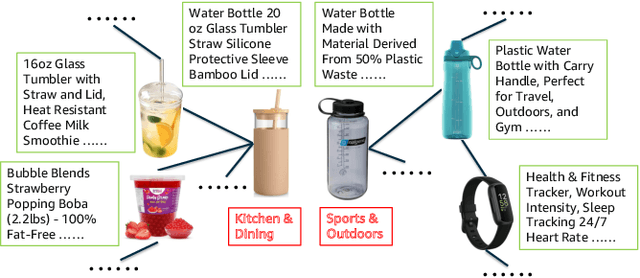
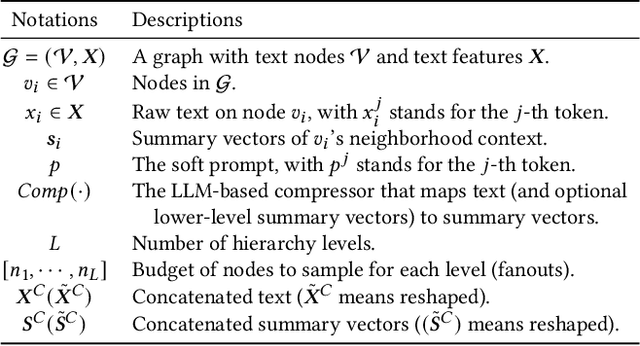


Abstract:Text-rich graphs, prevalent in data mining contexts like e-commerce and academic graphs, consist of nodes with textual features linked by various relations. Traditional graph machine learning models, such as Graph Neural Networks (GNNs), excel in encoding the graph structural information, but have limited capability in handling rich text on graph nodes. Large Language Models (LLMs), noted for their superior text understanding abilities, offer a solution for processing the text in graphs but face integration challenges due to their limitation for encoding graph structures and their computational complexities when dealing with extensive text in large neighborhoods of interconnected nodes. This paper introduces ``Hierarchical Compression'' (HiCom), a novel method to align the capabilities of LLMs with the structure of text-rich graphs. HiCom processes text in a node's neighborhood in a structured manner by organizing the extensive textual information into a more manageable hierarchy and compressing node text step by step. Therefore, HiCom not only preserves the contextual richness of the text but also addresses the computational challenges of LLMs, which presents an advancement in integrating the text processing power of LLMs with the structural complexities of text-rich graphs. Empirical results show that HiCom can outperform both GNNs and LLM backbones for node classification on e-commerce and citation graphs. HiCom is especially effective for nodes from a dense region in a graph, where it achieves a 3.48% average performance improvement on five datasets while being more efficient than LLM backbones.
FeatNavigator: Automatic Feature Augmentation on Tabular Data
Jun 13, 2024Abstract:Data-centric AI focuses on understanding and utilizing high-quality, relevant data in training machine learning (ML) models, thereby increasing the likelihood of producing accurate and useful results. Automatic feature augmentation, aiming to augment the initial base table with useful features from other tables, is critical in data preparation as it improves model performance, robustness, and generalizability. While recent works have investigated automatic feature augmentation, most of them have limited capabilities in utilizing all useful features as many of them are in candidate tables not directly joinable with the base table. Worse yet, with numerous join paths leading to these distant features, existing solutions fail to fully exploit them within a reasonable compute budget. We present FeatNavigator, an effective and efficient framework that explores and integrates high-quality features in relational tables for ML models. FeatNavigator evaluates a feature from two aspects: (1) the intrinsic value of a feature towards an ML task (i.e., feature importance) and (2) the efficacy of a join path connecting the feature to the base table (i.e., integration quality). FeatNavigator strategically selects a small set of available features and their corresponding join paths to train a feature importance estimation model and an integration quality prediction model. Furthermore, FeatNavigator's search algorithm exploits both estimated feature importance and integration quality to identify the optimized feature augmentation plan. Our experimental results show that FeatNavigator outperforms state-of-the-art solutions on five public datasets by up to 40.1% in ML model performance.
GraphStorm: all-in-one graph machine learning framework for industry applications
Jun 10, 2024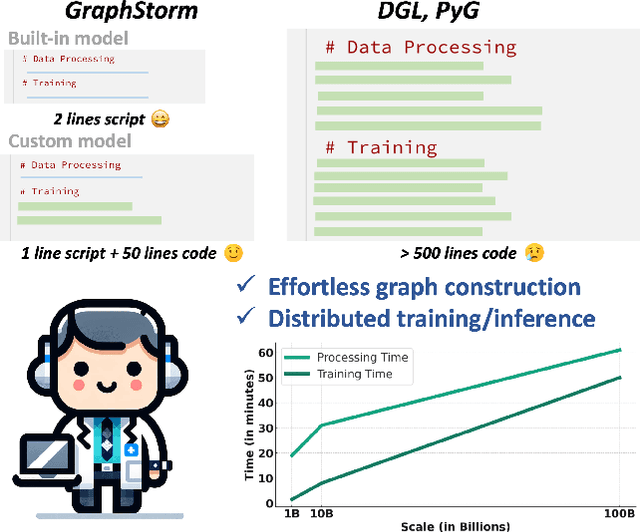

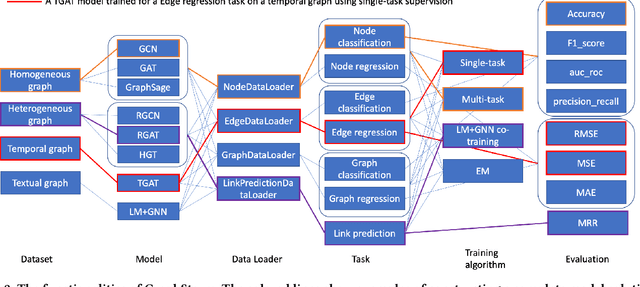

Abstract:Graph machine learning (GML) is effective in many business applications. However, making GML easy to use and applicable to industry applications with massive datasets remain challenging. We developed GraphStorm, which provides an end-to-end solution for scalable graph construction, graph model training and inference. GraphStorm has the following desirable properties: (a) Easy to use: it can perform graph construction and model training and inference with just a single command; (b) Expert-friendly: GraphStorm contains many advanced GML modeling techniques to handle complex graph data and improve model performance; (c) Scalable: every component in GraphStorm can operate on graphs with billions of nodes and can scale model training and inference to different hardware without changing any code. GraphStorm has been used and deployed for over a dozen billion-scale industry applications after its release in May 2023. It is open-sourced in Github: https://github.com/awslabs/graphstorm.
Evaluating Durability: Benchmark Insights into Multimodal Watermarking
Jun 06, 2024



Abstract:With the development of large models, watermarks are increasingly employed to assert copyright, verify authenticity, or monitor content distribution. As applications become more multimodal, the utility of watermarking techniques becomes even more critical. The effectiveness and reliability of these watermarks largely depend on their robustness to various disturbances. However, the robustness of these watermarks in real-world scenarios, particularly under perturbations and corruption, is not well understood. To highlight the significance of robustness in watermarking techniques, our study evaluated the robustness of watermarked content generated by image and text generation models against common real-world image corruptions and text perturbations. Our results could pave the way for the development of more robust watermarking techniques in the future. Our project website can be found at \url{https://mmwatermark-robustness.github.io/}.
4DBInfer: A 4D Benchmarking Toolbox for Graph-Centric Predictive Modeling on Relational DBs
Apr 28, 2024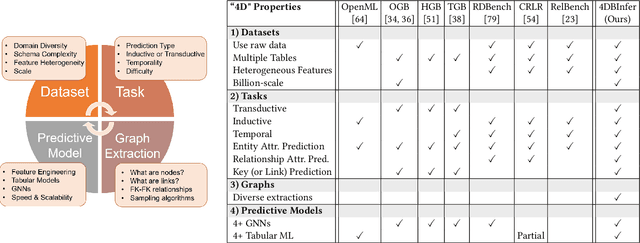
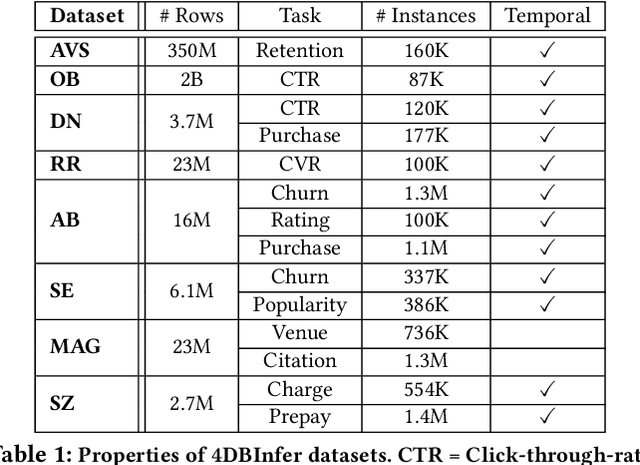

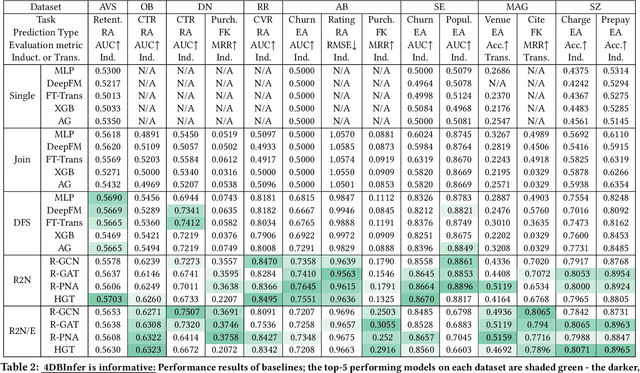
Abstract:Although RDBs store vast amounts of rich, informative data spread across interconnected tables, the progress of predictive machine learning models as applied to such tasks arguably falls well behind advances in other domains such as computer vision or natural language processing. This deficit stems, at least in part, from the lack of established/public RDB benchmarks as needed for training and evaluation purposes. As a result, related model development thus far often defaults to tabular approaches trained on ubiquitous single-table benchmarks, or on the relational side, graph-based alternatives such as GNNs applied to a completely different set of graph datasets devoid of tabular characteristics. To more precisely target RDBs lying at the nexus of these two complementary regimes, we explore a broad class of baseline models predicated on: (i) converting multi-table datasets into graphs using various strategies equipped with efficient subsampling, while preserving tabular characteristics; and (ii) trainable models with well-matched inductive biases that output predictions based on these input subgraphs. Then, to address the dearth of suitable public benchmarks and reduce siloed comparisons, we assemble a diverse collection of (i) large-scale RDB datasets and (ii) coincident predictive tasks. From a delivery standpoint, we operationalize the above four dimensions (4D) of exploration within a unified, scalable open-source toolbox called 4DBInfer. We conclude by presenting evaluations using 4DBInfer, the results of which highlight the importance of considering each such dimension in the design of RDB predictive models, as well as the limitations of more naive approaches such as simply joining adjacent tables. Our source code is released at https://github.com/awslabs/multi-table-benchmark .
 Add to Chrome
Add to Chrome Add to Firefox
Add to Firefox Add to Edge
Add to Edge